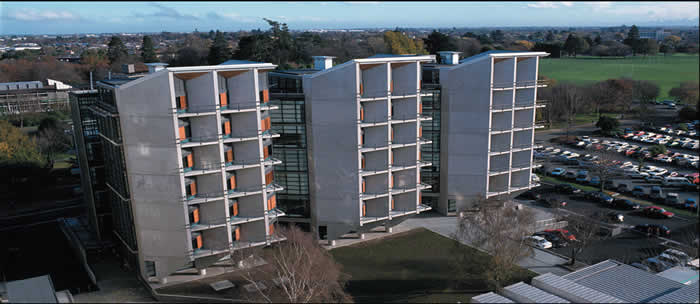
The Maths, Statistics and Computer Science Building (MSCS) at the University of Canterbury was designed to include passive heating, cooling and ventilation features to help it achieve the required energy target that was set at the beginning of the project. This was supported by both the architects’ and engineers’ desire for a passive low-energy building, maximising both natural ventilation and large amounts of daylight. Thermal modelling and computational fluid dynamics were used to assess the comfort levels of spaces in the building. Integrated features of the building perform multiple functions where possible to minimise materials use and recognise the interconnectedness of some of the design principles.
The 11,500m2 building consists of two main accommodation blocks either side of a five-storey atrium. The northern block contains staff and postgraduate offices, while the second block (at the rear in the photo above) contains the undergraduate teaching areas. A basement under the atrium contains further teaching and service spaces, with circulation towers enclosing the glass-roofed atrium at each end.
All staff have access to a user manual for the building to ensure the building is used as the design team intended. In a 2001 post-occupancy evaluation, students and staff rated the building highly. It reached a level of satisfaction (measured by noise, lighting, overall comfort, summer and winter temperatures) in the top five percentile of the 2001 benchmark data set. All user control ratings were in the top 15 per cent of the benchmark data set, significantly higher than the benchmark.
6.1.1: Site
The building has its long axis lying north-west to south-east and follows the university grid pattern. The building is in the new Science West Precinct that will also include the Future Sciences Library building. The MSCS building and the Future Sciences Library building share a new, centrally located artesian borehole for cooling. The borehole water is discharged back to and supplements the flow back in the nearby Oakover stream. Offices are placed to maximise views of the Southern Alps. The more densely occupied teaching facility with computers is oriented to the south. The sun is controlled to the east and west by massive shear walls with restricted openings. Thermal mass was used specifically to provide stable and natural temperature control for Canterbury’s wide range of temperatures, thanks to the north-west/ southerly wind shifts.
6.1.2: Natural ventilation
The 6.8 m wide atrium is used to help natural ventilation through the building. Fresh air is drawn through the accommodation blocks, through a double height space and into the atrium via automated internal windows. The academic offices have a very high level of individual control with a variety of natural ventilation options available to the occupants shown below. The vents, openable windows, louvres and shutters are also effective in controlling internal temperatures with little reliance on external energy. In the post-occupancy review, it was found that overall air quality was rated highly, while noise levels were found to be generally acceptable. This is an excellent result for a naturally ventilated building.
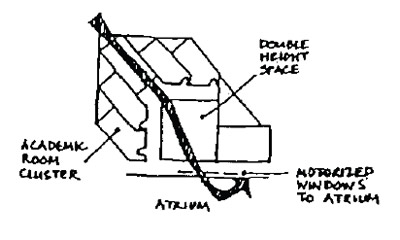
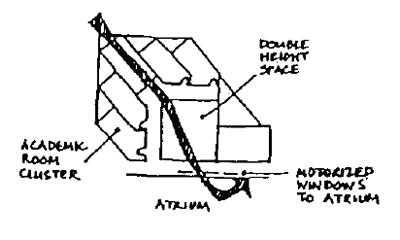
6.1.3: Passive heating and cooling
Temperatures are controlled using thermally massive materials, predominantly exposed concrete. The offices have exposed concrete walls and the teaching areas exposed structural floor slabs. The floor slabs are sinusoidal in shape with the voids being used as air supply ducts (and for cable reticulation) while also providing a large, column-free floor plate. This use of the slab’s thermal mass helps maintain an even internal temperature.
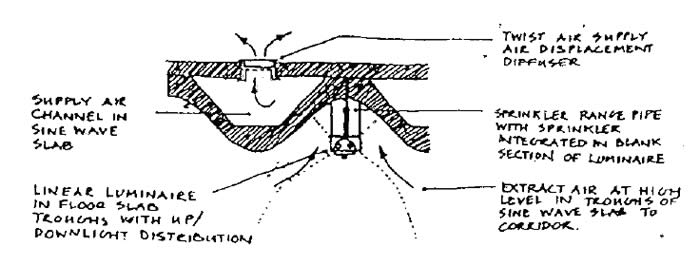
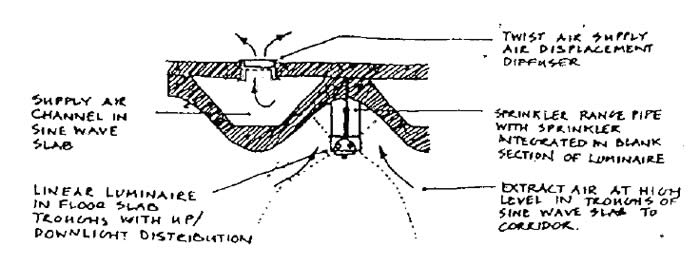
The passive features were supplemented with active systems where required, particularly areas of high internal gains, such as the teaching levels and computer suites. Aquifer ground water was used for heat rejection from the main chillers for improved energy efficiency.
Summer and winter temperatures were rated as comfortable by both staff and students (ie, both permanent and transient occupants) during the post-occupancy review.
6.1.4: Daylighting
The main daylighting feature is again the central atrium. Its sloping glazed roof is oriented to the south-west to give high daylight penetration, rather than sunlight, while its internal walls to the adjoining wings are fully glazed. The intermediate spaces between the atrium and the rear of the offices are double height to maximise the amount of daylight reaching the occupied areas of the building.
As the offices are on the northern facade of the building, they require a well-thought-out shading strategy to allow good daylighting while reducing any possible glare effects. The office’s facade design incorporates several movable shades and adjustable louvres so the occupants can alter the level of light to suit their needs.
The supplementary electric lighting system has been designed to be highly efficient with an electricity consumption of 9 W/m2(half the New Zealand standard at the time). Occupants rated lighting, both natural and artificial, highly in the post-occupancy review.
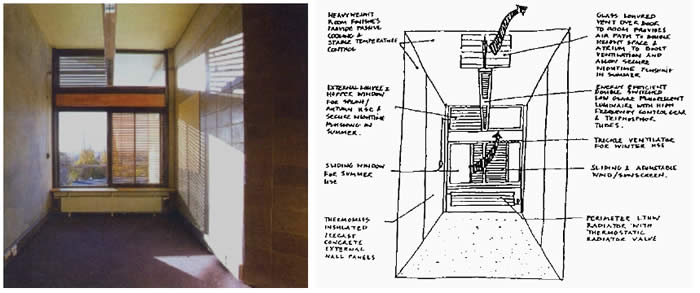
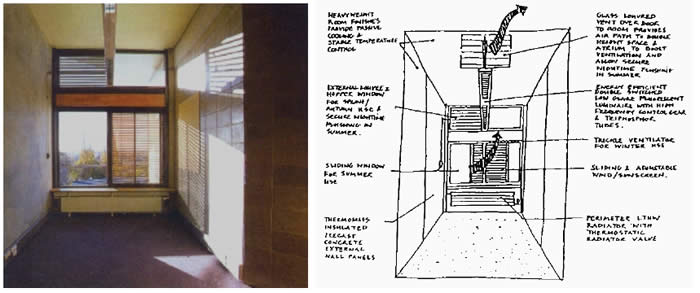
6.1.5: Economics
The cost of the project was calculated as being $2,000/m2 which is 15 per cent below the estimated conventional cost of $2,300/m2 (Ministry for the Environment, 2007). An energy audit showed the annual energy consumption to be 140kWh/m2 which is below the standard annual energy consumption for a building of this size at 185kWh/m2 (Ministry for the Environment, 2007).
In 2001, a post-occupancy evaluation was carried out on the building to give occupants feedback on its performance and to compare the ratings with UK national benchmarks. The UK benchmark for perceived productivity for 2001 was minus 1.87 per cent. The productivity score at MSCS was plus 9.80 per cent (percentile 97 per cent). This should be read to mean ‘occupants think that the building boosts their productivity at work by about 10 per cent, compared with their experience of other working environments’.
6.1.6: Credits
Client: University of Canterbury
Project manager: University of Canterbury
Architects: Architectus CHS Royal Associates
Quantity surveyors: Shipston Davies
Contractor: Naylor Love
Mechanical, electrical and fire engineers: Ove Arup and Partners New Zealand Ltd
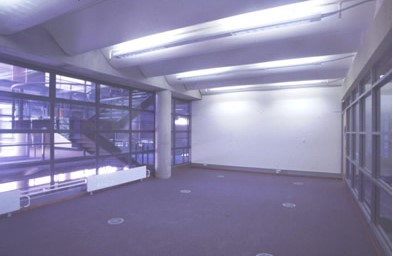
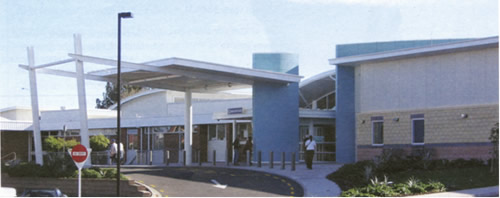
The Waitemata District Health Board and Waitakere City Council worked in partnership with the community to ensure their new hospital fitted within Waitakere City’s Eco City vision. As part of the project development, a series of environmental design principles were created which underpinned the design direction. These included energy efficiency, maximising the use of natural lighting and, being a hospital, additional environmentally friendly strategies which included avoiding waste, safe disposal of hazardous goods and various water-saving and treatment features.
The 14,700 m2 building houses 82 beds over five wards and includes operating theatres, a radiology and imaging department, emergency department and acute assessment unit, plus the hospital’s support services such as kitchens and cafeteria.
6.2.1: Site
The hospital is located in a residential area of central Waitakere on a site large enough to contain car parking, and stormwater retention ponds that provide a public amenity for the site. The site has excellent solar access, as there is no overshadowing from surrounding buildings. Similarly, the openness allows a reasonable breeze for natural ventilation, the only obstacle being the building itself.
The site development included partial refurbishment of existing buildings and the construction of new facilities. Swales and rain gardens are used to deal with run-off from car parks. Public access has been improved and made easier with a barrier-free philosophy.
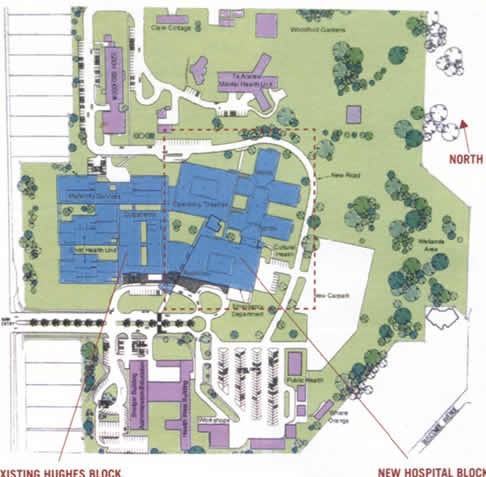
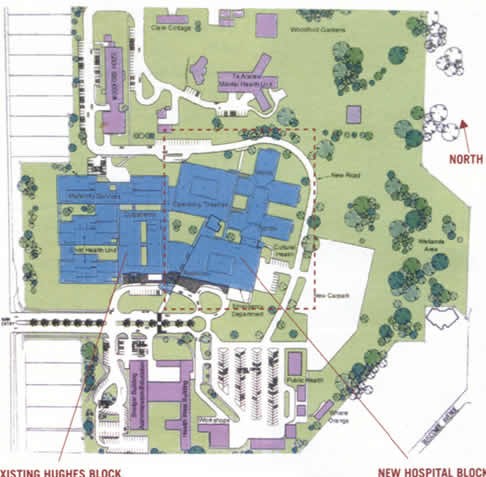
6.2.3: Natural ventilation
The orientation of the building was adjusted to improve natural ventilation and to reduce the risk of overheating. Courtyards were created in the middle of the new buildings to bring sun, light and air into the interior and provide green space for the occupants.
Natural ventilation was used as much as possible. This meant splitting the building into air-conditioned zones, such as operating theatres, and naturally ventilated zones, such as older wards and public areas. The intention was to create healthy and low-energy environments closely in tune with the outdoor environment.
The supplemental air supply systems made use of the partial recirculation of air using an economiser cycle. This improves the efficiency of the system by using outside air for cooling when conditions permit. This approach reduces operating costs for the building.
6.2.3: Passive heating and cooling
The design is relatively lightweight and relies on insulation rather than thermal mass to maintain comfortable temperatures. The levels of insulation were increased from Building Code levels, with R 2.0 insulation in the walls and R 3.5 in the ceiling. Fibreglass was used in encapsulated locations and polyester in exposed locations.
Solar shading and special glass was specified on the northern windows of the wards to avoid overheating. It is unreasonable to expect that passive design features will adequately condition all areas of the building due to the highly serviced nature of the building type. Waitakere Hospital makes the best use of passive systems where they are most suitable.
6.2.4: Daylighting
The use of natural light and a connection to the outdoors was integral to the design as, anecdotally, they are beneficial to a patient’s recovery. The courtyard design brings daylight into the building, while deeper-than-usual windows still allow bed-bound patients a direct view outdoors. Because patients have restricted movement, shading is used to reduce glare effects from direct sun. Double-height ceilings are used in transient areas to allow high daylight penetration and reduce reliance on artificial lighting.
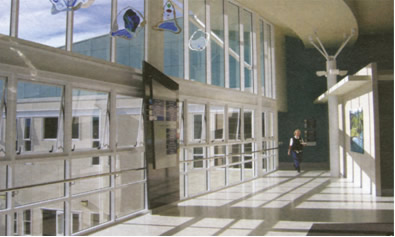
Where artificial lighting is required, energy consumption is further reduced using daylight dimming, localised switching, and high-efficiency fittings and ballasts.
6.2.5: Economics
Energy modelling and lifecycle costing on systems and construction was used to identify real opportunities for cost-effective design. Adding sustainable building strategies was initially seen as too expensive, but a subsequent feasibility study and loan funded by the Energy Efficiency and Conservation Authority (EECA) under its design energy audit and Crown loan scheme proved otherwise. For example, the natural ventilation strategy had an initial cost premium of $50,000 and a simple payback of 0.33 years. A grant was also received from Infrastructure Auckland for the stormwater measures included in the project. The overall premium was estimated to be 1.5 per cent above the conventional cost.
6.2.6: Credits
Client: Waitemata District Health Board
Project manager: Carson Group
Architects: Di Carlo Potts Architects (Sydney)
Quantity surveyors: Rider Hunt
Services engineers and energy consultant: Connell Mott MacDonald
Civil engineer: Harrison Grierson
Structural engineer: Buller George
Sustainable design consultant: Robert Vale, Waitakere City Council Sustainable Design Advisor
See more on...
6: Case Studies
December 2008
© Ministry for the Environment